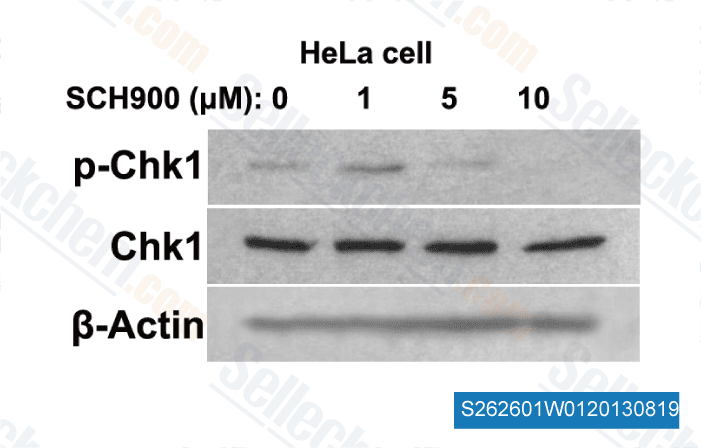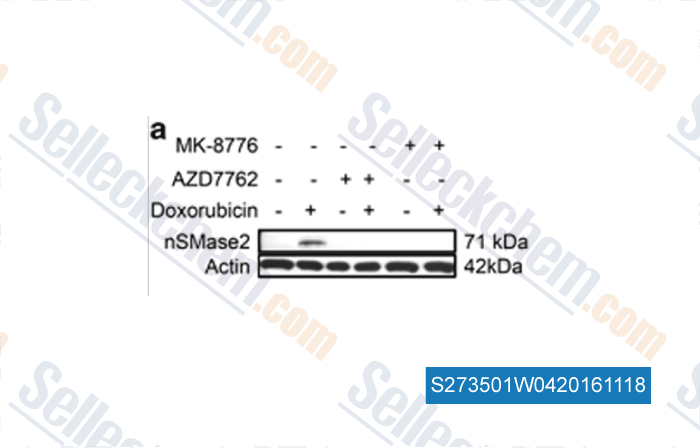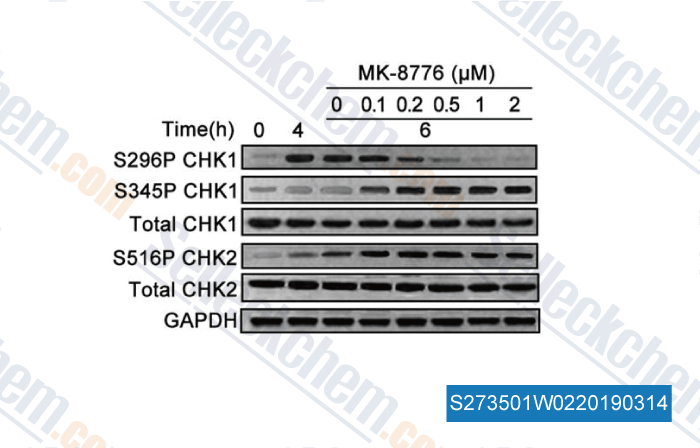|
Toll Free: (877) 796-6397 -- USA and Canada only -- |
Fax: +1-832-582-8590 Orders: +1-832-582-8158 |
Tech Support: +1-832-582-8158 Ext:3 Please provide your Order Number in the email. |
Technical Data
| Formula | C15H18BrN7 |
|||
| Molecular Weight | 376.25 | CAS No. | 891494-63-6 | |
| Solubility (25°C)* | In vitro | DMSO | 3 mg/mL (7.97 mM) | |
| Water | Insoluble | |||
| Ethanol | Insoluble | |||
|
* <1 mg/ml means slightly soluble or insoluble. * Please note that Selleck tests the solubility of all compounds in-house, and the actual solubility may differ slightly from published values. This is normal and is due to slight batch-to-batch variations. * Room temperature shipping (Stability testing shows this product can be shipped without any cooling measures.) |
||||
Preparing Stock Solutions
Biological Activity
| Description | MK-8776 (SCH 900776) is a selective Chk1 inhibitor with IC50 of 3 nM in a cell-free assay. It shows 500-fold selectivity against Chk2. Phase 2. | ||||
|---|---|---|---|---|---|
| Targets |
|
||||
| In vitro | SCH 900776 is a less potent inhibitor of Chk2 and CDK2 with IC50 of 1.5 μM and 0.16 μM, respectively. SCH 900776 shows no significant inhibition of cytochrome P450 human liver microsomal isoforms 1A2, 2C9, 2C19, 2D6, and 3A4. In combination with an antimetabolite, SCH 900776 induces accumulation of γ-H2AX within 2 hours, indicative of replication fork collapse and double stranded DNA breaks. Additionally, SCH 900776 suppresses accumulation of the Chk1 pS296 autophosphorylation in a dose-dependent manner. Exposure of proliferating WS1 cells to SCH 900776 is associated with rapid, dose-dependent accumulation of Chk1 pS345, indicating that cycling populations of normal cells induce Chk1 pS345 following exposure to SCH 900776 as part of a futile cycle, perhaps driven by AT-family kinases and DNA-PK.[1] |
||||
| In vivo | Dose escalation of SCH 900776 (16 mg/kg and 32 mg/kg) induces incremental improvements in tumor response. Importantly, doses of SCH 900776 associate with robust biomarker activation and improved tumor response are not associated with enhanced toxicity on hematological parameters in BALB/c mice. [1] |
Protocol (from reference)
| Kinase Assay: |
|
|---|---|
| Cell Assay: |
|
| Animal Study: |
|
References
Customer Product Validation

-
,

-
Data from [Data independently produced by , , Biomaterials, 2018, 182:35-43]

-
Data from [Data independently produced by , , Cell Death Dis, 2015, 6:e1947.]

-
Data from [Data independently produced by , , Sci Rep, 2017, 7(1):15031]
Selleck's MK-8776 (SCH 900776) has been cited by 79 publications
| Targeting Chk1 and Wee1 kinases enhances radiosensitivity of 2D and 3D head and neck cancer models to X-rays and low/high-LET protons [ Cell Death Dis, 2025, 16(1):128] | PubMed: 39994186 |
| Nuclear PD-L1 triggers tumour-associated inflammation upon DNA damage [ EMBO Rep, 2025, 10.1038/s44319-024-00354-9] | PubMed: 39747659 |
| MK-8776 and Olaparib Combination Acts Synergistically in Hepatocellular Carcinoma Cells, Demonstrating Lack of Adverse Effects on Liver Tissues in Ovarian Cancer PDX Model [ Int J Mol Sci, 2025, 26(2)834] | PubMed: 39859548 |
| Precise nano-system-based drug delivery and synergistic therapy against androgen receptor-positive triple-negative breast cancer [ Acta Pharm Sin B, 2024, 14(6):2685-2697] | PubMed: 38828153 |
| ATR limits Rad18-mediated PCNA monoubiquitination to preserve replication fork and telomerase-independent telomere stability [ EMBO J, 2024, 43(7):1301-1324] | PubMed: 38467834 |
| WEE1 confers resistance to KRASG12C inhibitors in non-small cell lung cancer [ Cancer Lett, 2024, 611:217414] | PubMed: 39725152 |
| Irradiated tumour cell-derived microparticles upregulate MHC-I expression in cancer cells via DNA double-strand break repair pathway [ Cancer Lett, 2024, 592:216898] | PubMed: 38670306 |
| Natural pentacyclic triterpenoid from Pristimerin sensitizes p53-deficient tumor to PARP inhibitor by ubiquitination of Chk1 [ Pharmacol Res, 2024, 201:107091] | PubMed: 38316371 |
| Synthetic lethality between ATR and POLA1 reveals a potential new target for individualized cancer therapy [ Neoplasia, 2024, 57:101038] | PubMed: 39128273 |
| Transcriptional Differential Analysis of Nitazoxanide-Mediated Anticanine Parvovirus Effect in F81 Cells [ Viruses, 2024, 16(2)282] | PubMed: 38400057 |
RETURN POLICY
Selleck Chemical’s Unconditional Return Policy ensures a smooth online shopping experience for our customers. If you are in any way unsatisfied with your purchase, you may return any item(s) within 7 days of receiving it. In the event of product quality issues, either protocol related or product related problems, you may return any item(s) within 365 days from the original purchase date. Please follow the instructions below when returning products.
SHIPPING AND STORAGE
Selleck products are transported at room temperature. If you receive the product at room temperature, please rest assured, the Selleck Quality Inspection Department has conducted experiments to verify that the normal temperature placement of one month will not affect the biological activity of powder products. After collecting, please store the product according to the requirements described in the datasheet. Most Selleck products are stable under the recommended conditions.
NOT FOR HUMAN, VETERINARY DIAGNOSTIC OR THERAPEUTIC USE.
